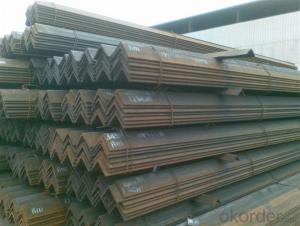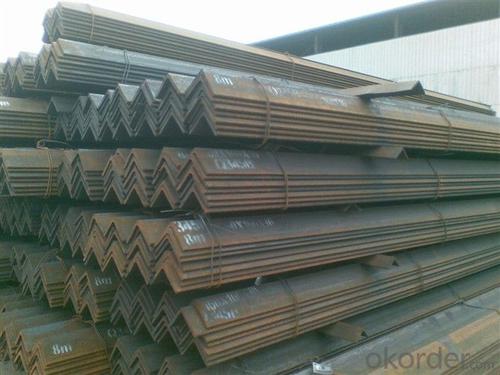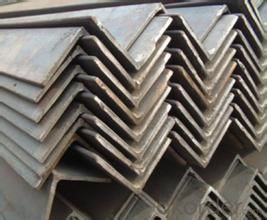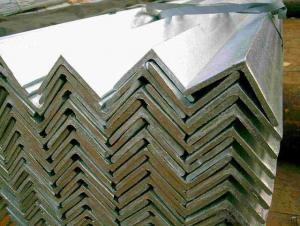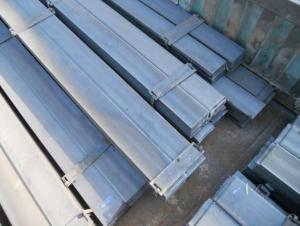Q345 Material High Quality Angle Steel
- Loading Port:
- Tianjin
- Payment Terms:
- TT or LC
- Min Order Qty:
- 25 m.t.
- Supply Capability:
- 2000 m.t./month
OKorder Service Pledge
OKorder Financial Service
You Might Also Like
Product Description:
OKorder is offering Angle Steel great prices with worldwide shipping. Our supplier is a world-class manufacturer of steel, with our products utilized the world over. OKorder annually supplies products to European, North American and Asian markets. We provide quotations within 24 hours of receiving an inquiry and guarantee competitive prices.
Product Applications:
According to the needs of different structures, Angle can compose to different force support component, and also can be the connections between components. It is widely used in various building structures and engineering structures such as roof beams, bridges, transmission towers, hoisting machinery and transport machinery, ships, industrial furnaces, reaction tower, container frame and warehouse etc.
Product Advantages:
OKorder's Angle Steelare durable, strong, and resist corrosion.
Main Product Features:
· Premium quality
· Prompt delivery & seaworthy packing (30 days after receiving deposit)
· Corrosion resistance
· Can be recycled and reused
· Mill test certification
· Professional Service
· Competitive pricing
Product Specifications:
1. Invoicing on theoretical weight or actual weight as customer request
2. Length: 6m, 9m, 12m as following table
3. Sizes
Sizes: 25mm-250mm | ||
a*t | ||
25*2.5-4.0 | 70*6.0-9.0 | 130*9.0-15 |
30*2.5-6.6 | 75*6.0-9.0 | 140*10-14 |
36*3.0-5.0 | 80*5.0-10 | 150*10-20 |
38*2.3-6.0 | 90*7.0-10 | 160*10-16 |
40*3.0-5.0 | 100*6.0-12 | 175*12-15 |
45*4.0-6.0 | 110*8.0-10 | 180*12-18 |
50*4.0-6.0 | 120*6.0-15 | 200*14-25 |
60*4.0-8.0 | 125*8.0-14 | 250*25 |
Note:
1. According to national standard (GB) for our products, if not, supply according to national standards (GB) or agreement.
2. We can not only provide electric furnace +LF+VD and electro-slag re-melting (ESR)steel forging materials, but also forging products of piece, bar, etc.
3. Our company is equipped with roll equipment and can provide our customers with roll billets or finished.
4. Please send us your detailed specifications when inquire. We will reply to you ASAP.
FAQ:
Q1: Why buy Materials & Equipment from OKorder.com?
A1: All products offered byOKorder.com are carefully selected from China's most reliable manufacturing enterprises. Through its ISO certifications, OKorder.com adheres to the highest standards and a commitment to supply chain safety and customer satisfaction.
Q2 What makes stainless steel stainless?
A2 Stainless steel must contain at least 10.5 % chromium. It is this element that reacts with the oxygen in the air to form a complex chrome-oxide surface layer that is invisible but strong enough to prevent further oxygen from "staining" (rusting) the surface. Higher levels of chromium and the addition of other alloying elements such as nickel and molybdenum enhance this surface layer and improve the corrosion resistance of the stainless material.
Q3 Can stainless steel rust?
A3 Stainless does not "rust" as you think of regular steel rusting with a red oxide on the surface that flakes off. If you see red rust it is probably due to some iron particles that have contaminated the surface of the stainless steel and it is these iron particles that are rusting. Look at the source of the rusting and see if you can remove it from the surface.
Images:
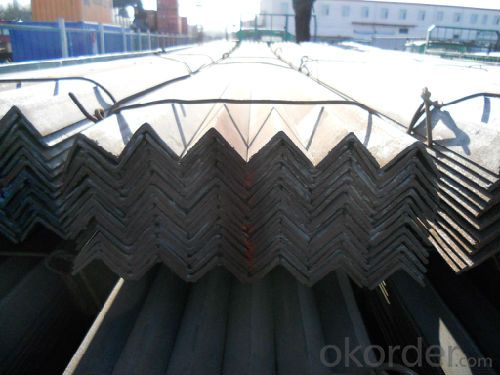
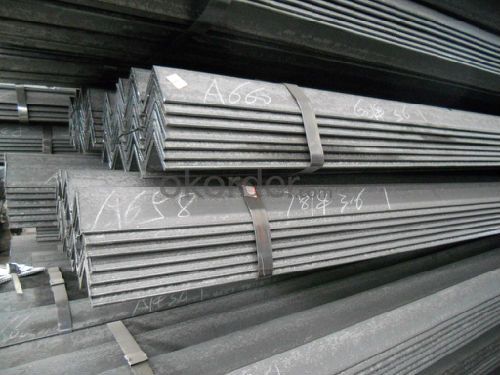
- Q:How do you calculate the torsional capacity of a steel angle?
- The torsional capacity of a steel angle can be calculated by determining the section modulus for torsion and multiplying it by the shear stress. The section modulus can be found using the dimensions of the angle, such as the width, height, and thickness. The shear stress is typically defined by the material's yield strength.
- Q:How do steel angles provide structural support?
- Structural support is provided by steel angles, which evenly and efficiently distribute weight and load in a structure. These L-shaped steel beams are commonly used in construction. The stability and strength of the angle's two legs enable it to resist bending and twisting forces. Steel angles are frequently combined with other structural components like beams, columns, and trusses to establish a stable framework. They can be connected to these components through bolting, welding, or other methods to offer additional support and reinforcement. Due to their versatility, steel angles can be utilized in various applications, including building frames, supports, bracing, and structural reinforcement. The incorporation of steel angles in a structure helps evenly distribute weight and load across different components, reducing the risk of structural failure. They effectively resist compressive, tensile, and bending forces, providing stability and preventing deformation under heavy loads or external forces like wind or earthquakes. Furthermore, steel angles serve to create secure connections and joints between different parts of a structure, ensuring their firm fastening. This enhances overall stability and integrity, making the structure more resistant to movement, vibrations, and other external factors that could compromise safety. In summary, steel angles play a vital role in providing structural support. They distribute weight, resist bending and twisting forces, enhance stability, and reinforce connections between different structural components. Their strength, versatility, and reliability make them a popular choice in construction projects where structural integrity and stability are paramount.
- Q:Are steel angles suitable for load-bearing walls in residential buildings?
- Yes, steel angles are suitable for load-bearing walls in residential buildings. Steel angles are commonly used in construction due to their high strength and durability. They are capable of supporting heavy loads and can provide stability to the structure. Additionally, steel angles can be easily installed and are cost-effective compared to other building materials. They are also fire-resistant, which is an important factor for ensuring the safety of residential buildings. Overall, steel angles are a reliable choice for load-bearing walls in residential buildings.
- Q:What is the maximum shear force for a steel angle?
- The maximum shear force for a steel angle depends on various factors such as the size, shape, and material properties of the angle. To determine the specific maximum shear force, it is essential to consult the relevant design codes, standards, or specifications that provide guidelines for calculating the shear capacity of steel angles.
- Q:Can steel angles be used in marine applications?
- Yes, steel angles can be used in marine applications. Steel angles are commonly used in the construction of ships, offshore platforms, and other marine structures due to their high strength and durability. They provide structural support and help distribute the weight and stress of the marine environment. Steel angles are resistant to corrosion, especially when coated with protective coatings or galvanized. However, it is important to select the appropriate grade of steel angle that is specifically designed for marine applications to ensure optimal performance and longevity in harsh saltwater environments.
- Q:How do steel angles contribute to the energy efficiency of a building?
- Steel angles can contribute to the energy efficiency of a building in several ways. Firstly, steel angles are commonly used as structural elements in the construction of buildings. They provide strength and support to the building's framework, allowing for the use of larger windows and open floor plans. This promotes natural daylighting and reduces the need for artificial lighting during the day, thereby reducing energy consumption. Additionally, steel angles can be used to create energy-efficient building envelopes. By incorporating steel angles into the construction of walls, roofs, and floors, thermal bridging can be minimized. Thermal bridging occurs when materials with high thermal conductivity, such as concrete or wood, allow heat to escape or enter the building, leading to increased energy consumption for heating or cooling. Steel, on the other hand, has a low thermal conductivity, which helps to reduce heat transfer and improve the overall thermal performance of the building envelope. Moreover, steel angles can be used in the installation of energy-saving systems and equipment. For instance, they can be used to support solar panels, which generate clean and renewable energy. Steel angles can also be utilized in the installation of HVAC systems, allowing for efficient air circulation and distribution throughout the building. By using steel angles in these applications, the energy efficiency of the building can be enhanced, leading to reduced energy consumption and lower utility bills. In conclusion, steel angles play a significant role in promoting energy efficiency in buildings. They contribute to the structural integrity of the building, help minimize thermal bridging, and can support the installation of energy-saving systems. By incorporating steel angles into the design and construction of a building, energy consumption can be reduced, resulting in a more sustainable and cost-effective built environment.
- Q:Can steel angles be used as bracing elements in a structure?
- Yes, steel angles can be used as bracing elements in a structure. Steel angles are commonly used in construction as they provide excellent strength and stability. When used as bracing elements, steel angles can effectively resist lateral forces and prevent structural deformation or collapse. They are often used to provide additional support and stability to structural members, such as beams or columns, by connecting them together at specific angles. Steel angles can be easily fabricated and installed, making them a versatile and cost-effective choice for bracing elements in various types of structures, including buildings, bridges, and industrial facilities.
- Q:How do you handle and install steel angles on a construction site?
- Handling and installing steel angles on a construction site requires careful planning and attention to detail. Here are the steps involved in handling and installing steel angles: 1. Preparing the site: Before handling steel angles, it is essential to ensure that the construction site is properly prepared. This includes clearing any debris or obstructions, ensuring a stable and level surface, and taking necessary safety precautions. 2. Measuring and marking: Accurate measurements of the steel angles' dimensions and their placement on the construction site are crucial. Using a measuring tape, determine the length, width, and thickness of the steel angles, and mark their intended locations on the site. This will ensure proper alignment and fit during the installation process. 3. Handling and transporting: Steel angles can be heavy, so it is important to use appropriate lifting equipment such as cranes, hoists, or forklifts to handle and transport them safely. Ensure that the lifting equipment is properly rated and operated by trained personnel to prevent accidents or damage to the steel angles. 4. Securing the steel angles: Once the steel angles are properly positioned, secure them in place using appropriate fasteners such as bolts, screws, or welding. The choice of fasteners depends on the specific requirements of the construction project and the load-bearing capacity of the steel angles. Make sure to follow the manufacturer's guidelines and industry standards for fastener selection and installation. 5. Checking alignment and levelness: After securing the steel angles, use a level and measuring tools to check their alignment and levelness. This step is crucial to ensure that the steel angles are installed correctly and will provide the necessary structural support. 6. Inspecting and reinforcing: Conduct a thorough inspection of the installed steel angles to ensure that they are free from any defects or damages. If any issues are identified, take appropriate measures to reinforce or replace the steel angles to maintain the structural integrity of the construction site. 7. Ongoing maintenance: Steel angles, like any other construction materials, require regular maintenance to extend their lifespan and prevent corrosion. Follow the manufacturer's recommendations for maintenance and periodically inspect the steel angles to identify and address any issues promptly. Overall, handling and installing steel angles on a construction site require careful planning, proper equipment, and adherence to safety guidelines. By following these steps, construction professionals can ensure the successful installation of steel angles, contributing to the overall strength and stability of the structure.
- Q:Can steel angles be used for temporary or removable structures?
- Yes, steel angles can be used for temporary or removable structures. Steel angles are versatile and commonly used in construction for various applications, including temporary or removable structures. They are often used as framing elements in scaffolding, support structures, and temporary partitions. Steel angles provide structural support and stability, making them suitable for temporary or removable structures that need to be strong and durable. Additionally, steel angles are easy to assemble and disassemble, allowing for convenient installation and removal of the temporary or removable structure.
- Q:Can steel angles be customized or fabricated to specific requirements?
- Yes, steel angles can be customized or fabricated to specific requirements.
1. Manufacturer Overview |
|
|---|---|
| Location | |
| Year Established | |
| Annual Output Value | |
| Main Markets | |
| Company Certifications | |
2. Manufacturer Certificates |
|
|---|---|
| a) Certification Name | |
| Range | |
| Reference | |
| Validity Period | |
3. Manufacturer Capability |
|
|---|---|
| a)Trade Capacity | |
| Nearest Port | |
| Export Percentage | |
| No.of Employees in Trade Department | |
| Language Spoken: | |
| b)Factory Information | |
| Factory Size: | |
| No. of Production Lines | |
| Contract Manufacturing | |
| Product Price Range | |
Send your message to us
Q345 Material High Quality Angle Steel
- Loading Port:
- Tianjin
- Payment Terms:
- TT or LC
- Min Order Qty:
- 25 m.t.
- Supply Capability:
- 2000 m.t./month
OKorder Service Pledge
OKorder Financial Service
Similar products
New products
Hot products
Hot Searches
Related keywords
